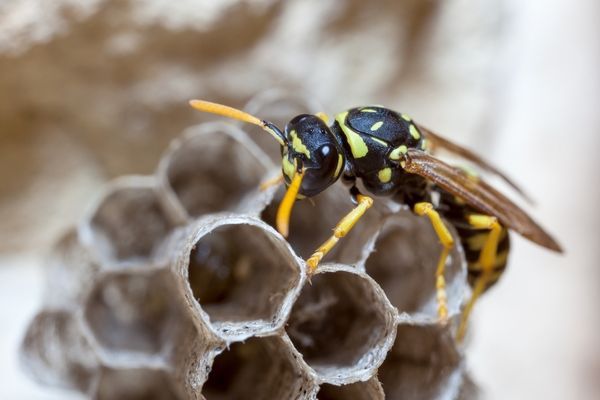Tuleyome's Science Corner - Paper Wasps and Yellowjackets

Paper Wasp and Nest
The Sacramento region is home to at two very common types of social wasps (wasps that live together in a community); paper wasps and yellowjackets. Both yellowjackets and paper wasps belong to the family Vespidae which contains about 1,100 species. Yellowjackets belong to the subfamily Vespinae which contains two genuses (Vespula and Dolichovespala). Paper wasps belong to the subfamily Polistinae which contains approximately 300 species worldwide, 22 of which are in California and belong to the genus Polistes.
Yellowjackets and paper wasps are commonly confused and misidentified because they look quite similar, however there are some notable differences if you don’t mind getting pretty close to them. Yellow jackets are typically black with yellow markings, are slightly less than an inch long and appear chunkier lacking the very tapered “wasp waist” that paper wasps display. Paper wasps are slightly bigger than yellowjackets, dark brown with yellow markings and have orange-tipped antennae and long rear legs that dangle behind them in flight. Both yellowjackets and paper wasps build nests out of paper which consists of chewed plant material, wood and saliva. Both begin nest construction which is made of rows of individual hexagonal cells in the early spring as the weather warms and the queen has emerged from hibernation. Depending on the species, yellowjacket nests can be underground often in abandoned rodent burrows (sometimes this species is called “meat bees”) while other species build a suspended nest from a structure or inside the walls of a building. Generally, yellowjacket nests they are much larger than paper wasp nests as the colonies can host many thousands of individuals and ends of the cells are sealed with a paper envelope so the embryo is not visible. Paper wasp nests are smaller with open hexagonal cells and they are always attached to a structure by a small stalk or pedicel and look like a tiny, hanging umbrella. Some species of paper wasps manufacture a chemical that keeps ants from crossing the pedicel and accessing their larvae. Colonies of paper wasps are much smaller and may only support 100 to 200 individuals. Rather than build a single large nest, paper wasps use several nest sites which may include the eaves of a house or shed, outdoor birdhouses, benches, grills and other outdoor structures and shrubbery.
I recently learned most wasp species, yellowjackets and paper wasps included, play an important role in biological pest control. In the early spring as wasp colonies are growing, they prey on species that impact crops such as caterpillars, aphids, beetle larvae and flies. In late summer and early fall the colonies forage on nectar to feed the queen and workers. As a result, they are also important pollinators. It is also this time when yellowjackets and wasps may come into more frequent contact with humans by swarming around trash cans, barbecues and even open soda cans looking for sweet things.
Generally speaking, paper wasps are shy of humans, far less defensive and much less prone to sting unless their nests are disturbed. Yellowjackets are more irritable and aggressive and seem to almost want to pick fights with humans. Like all wasps, both species can sting multiple times and although not common, anaphylactic reactions can occur. Studies have shown that some species that display brighter colors have larger venom glands and as a result are more venomous. It’s thought that the brighter color is a warning to keep predators away from the nest.
The Sacramento-Yolo Mosquito and Vector Control District website states that it is dangerous to confront a yellowjacket nest and they offer free help with nest removal. They can be contacted here for more information.
-Kristie Ehrhardt (kehrhardt@tuleyome.org)
Tuleyome Land Conservation Program Manager
RECENT ARTICLES






